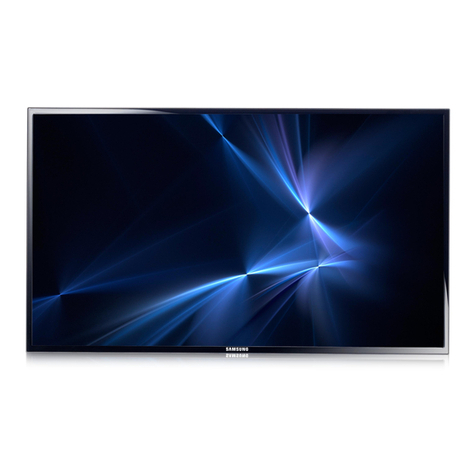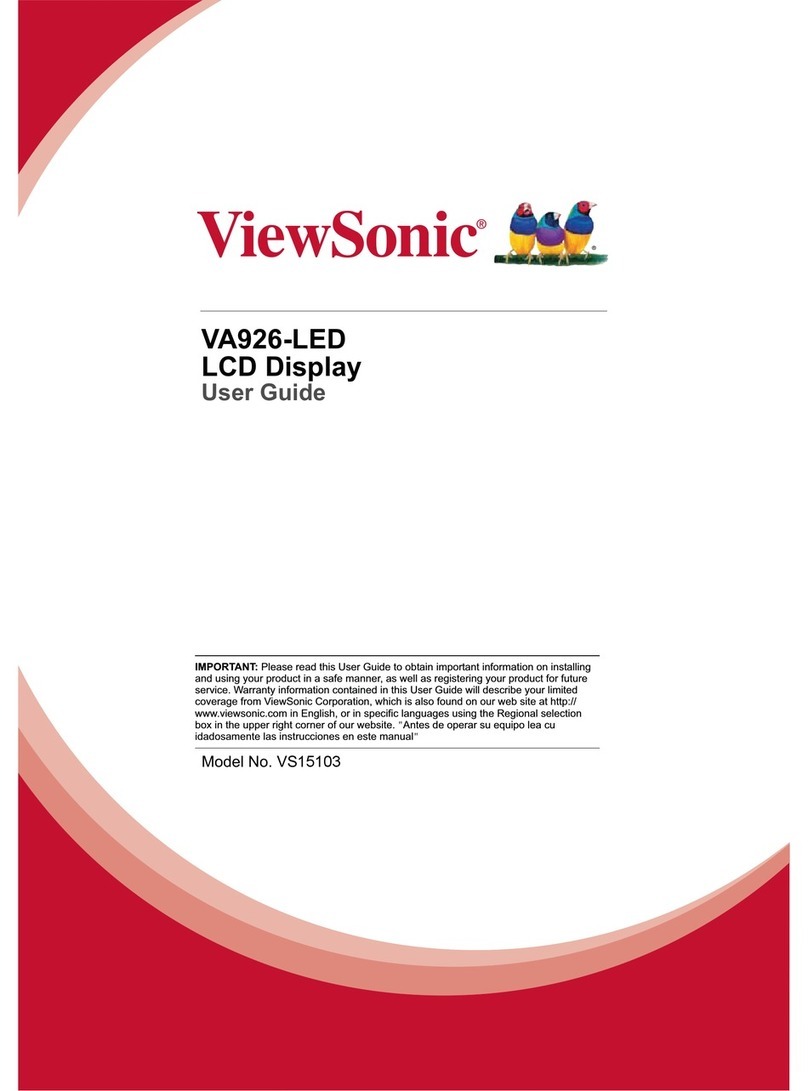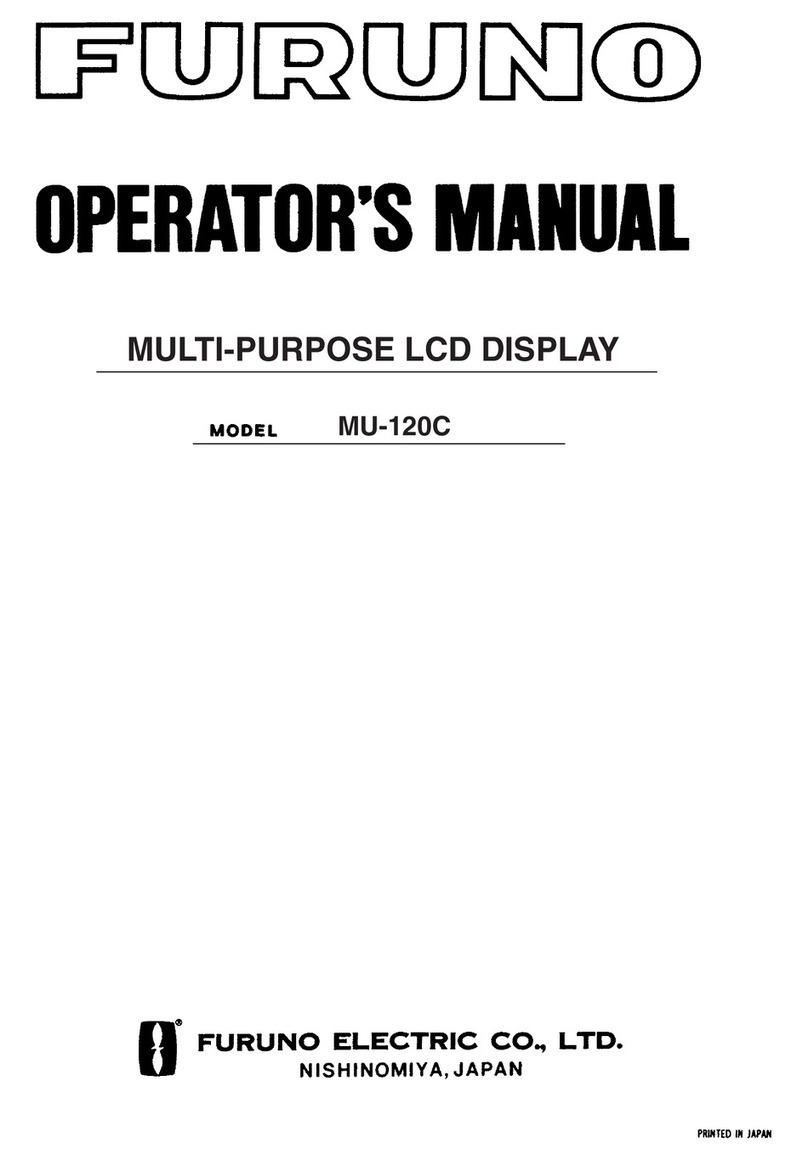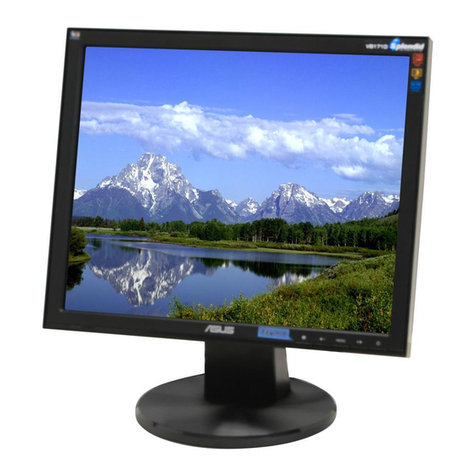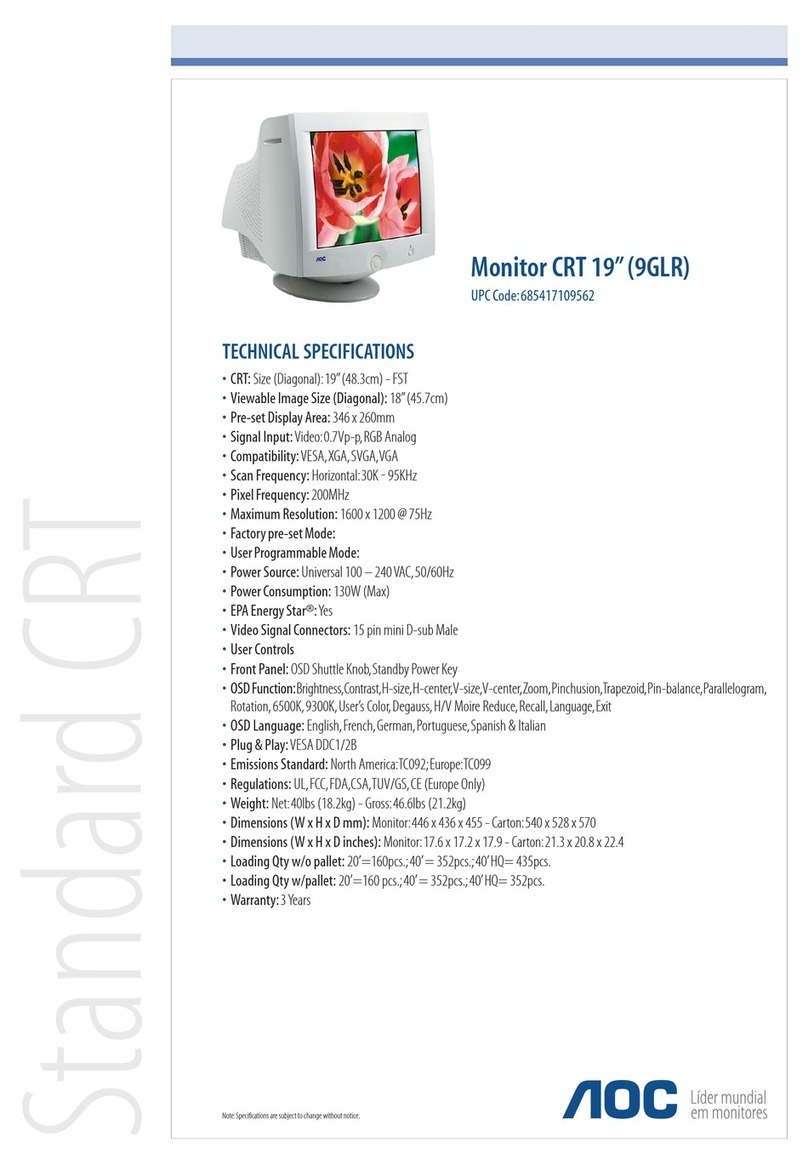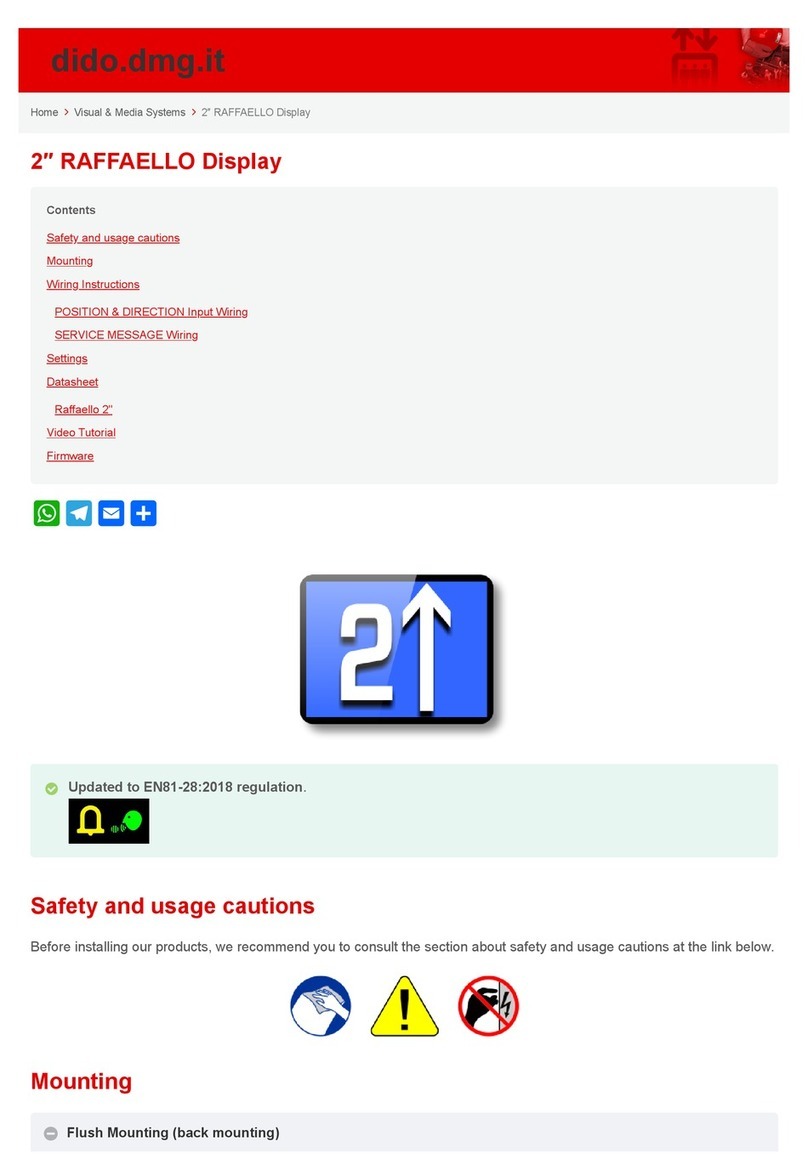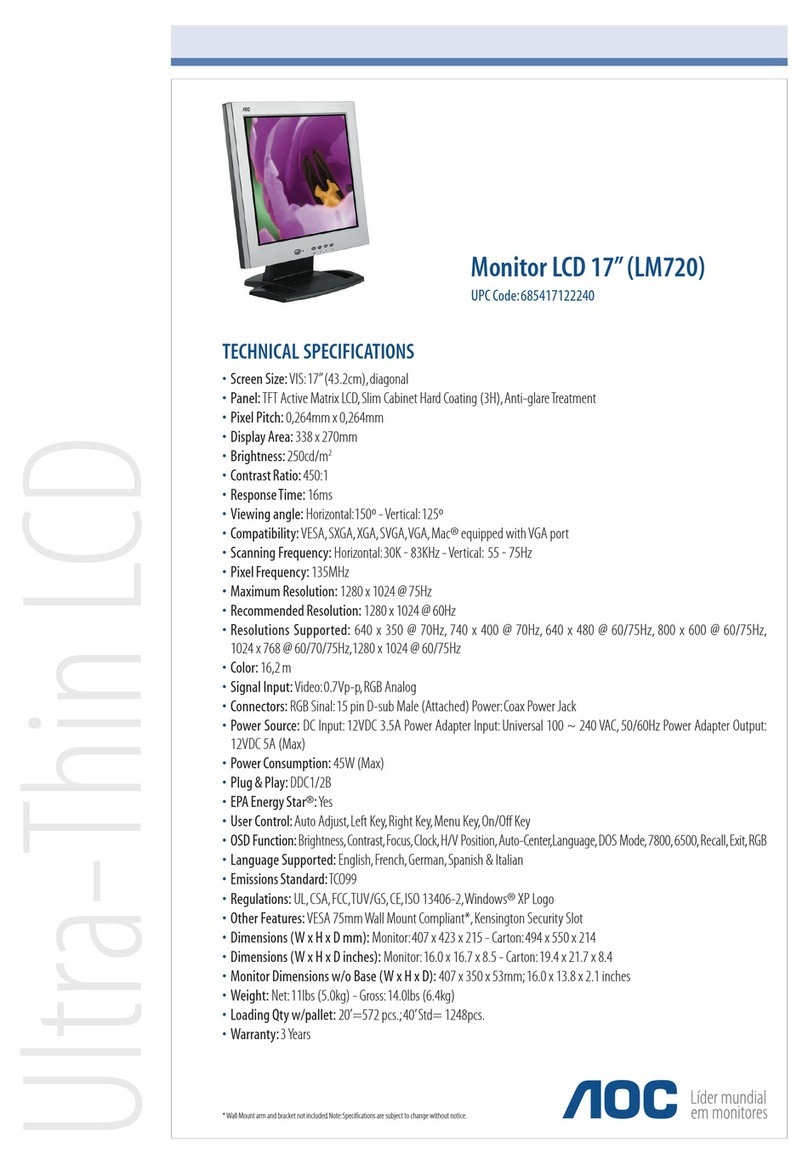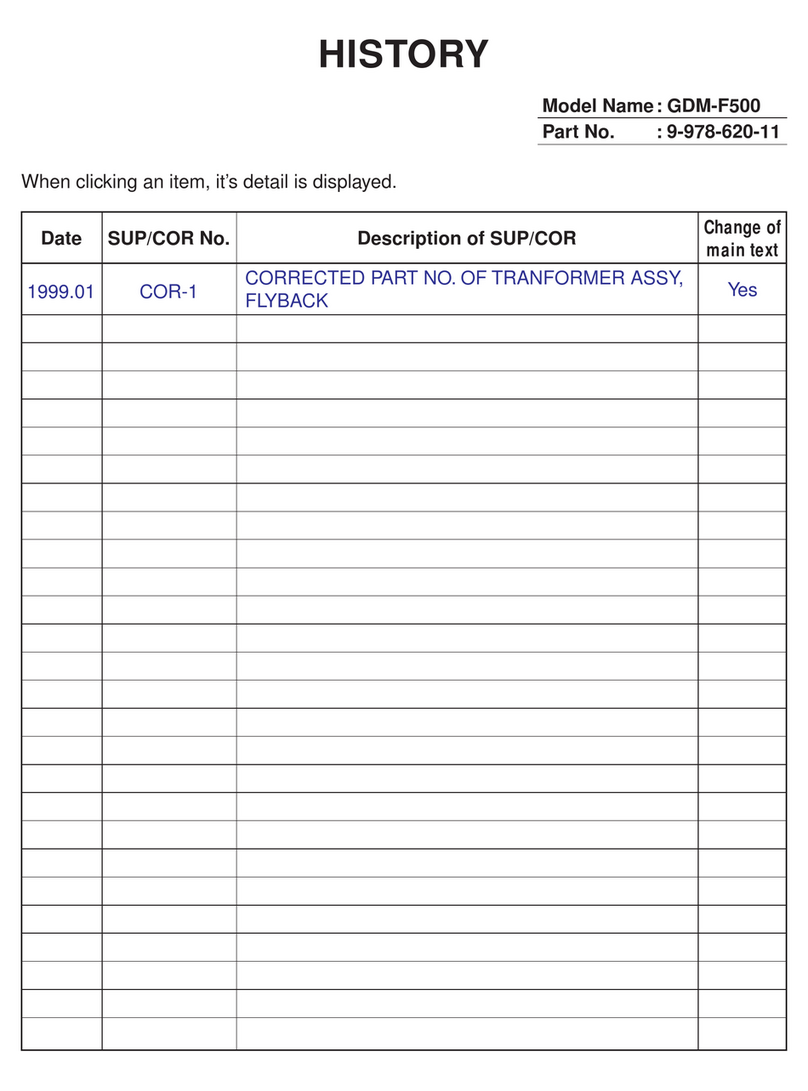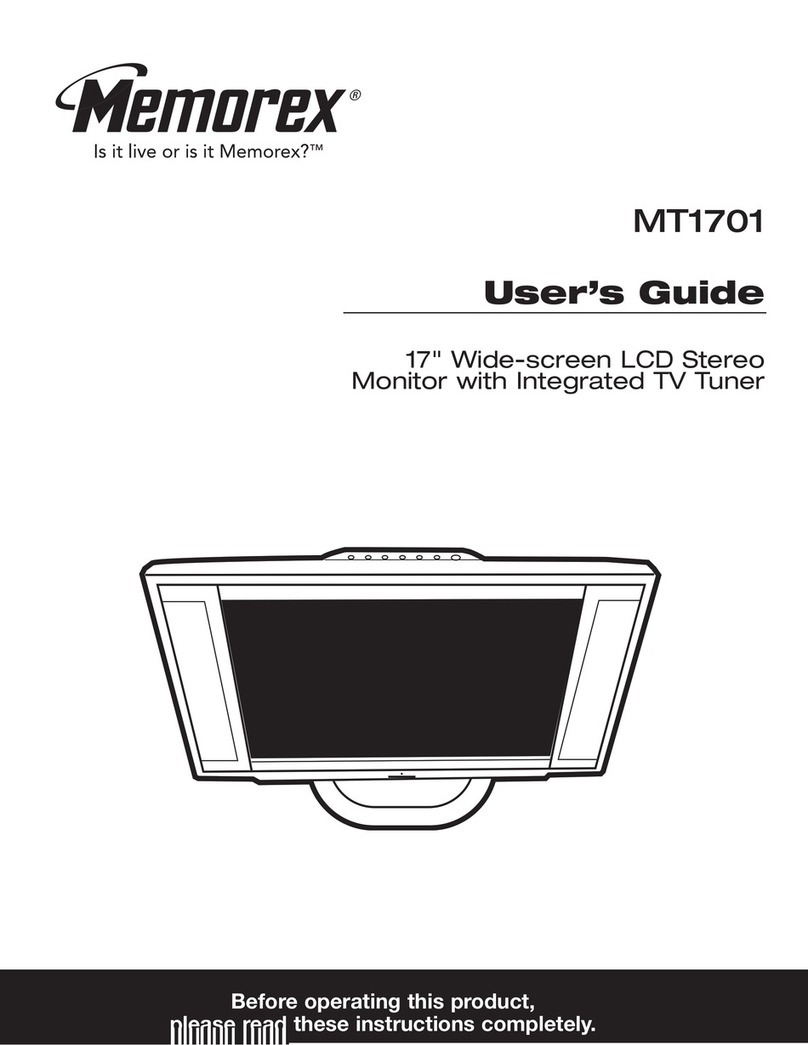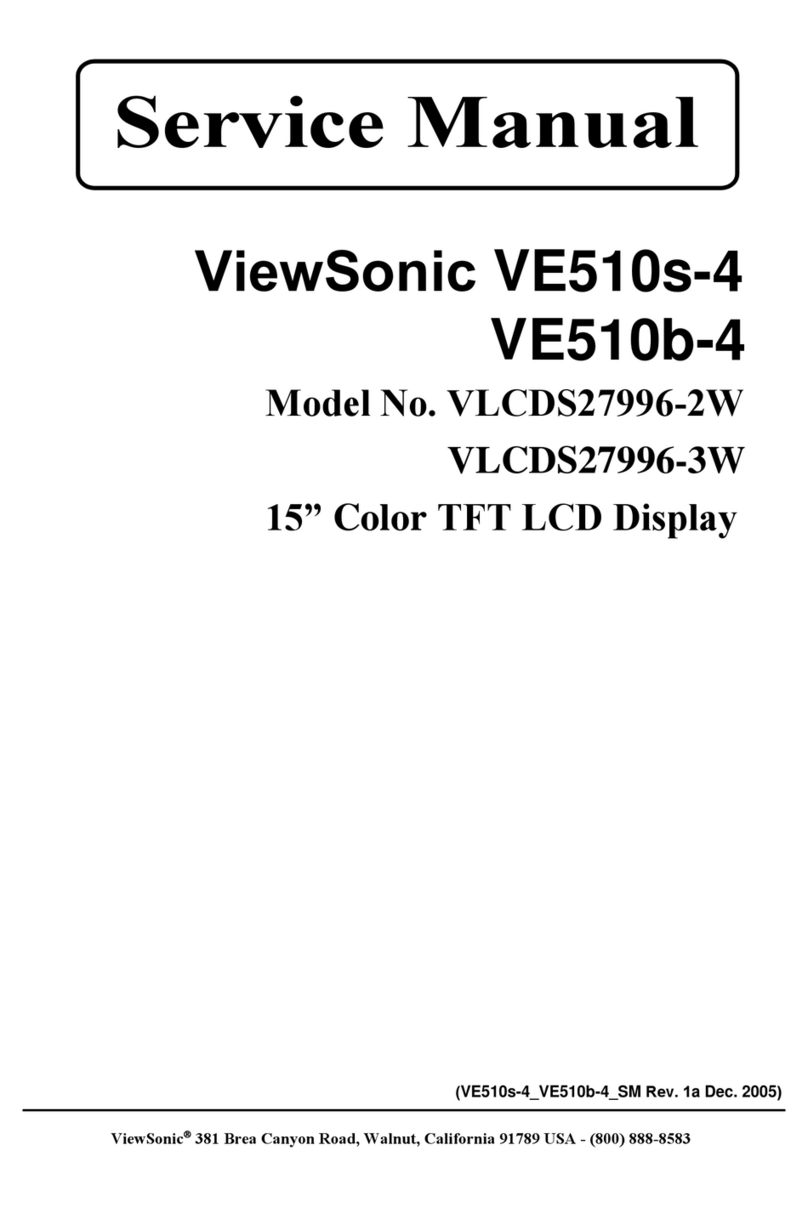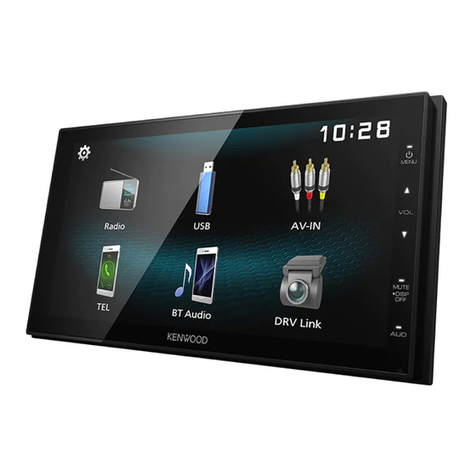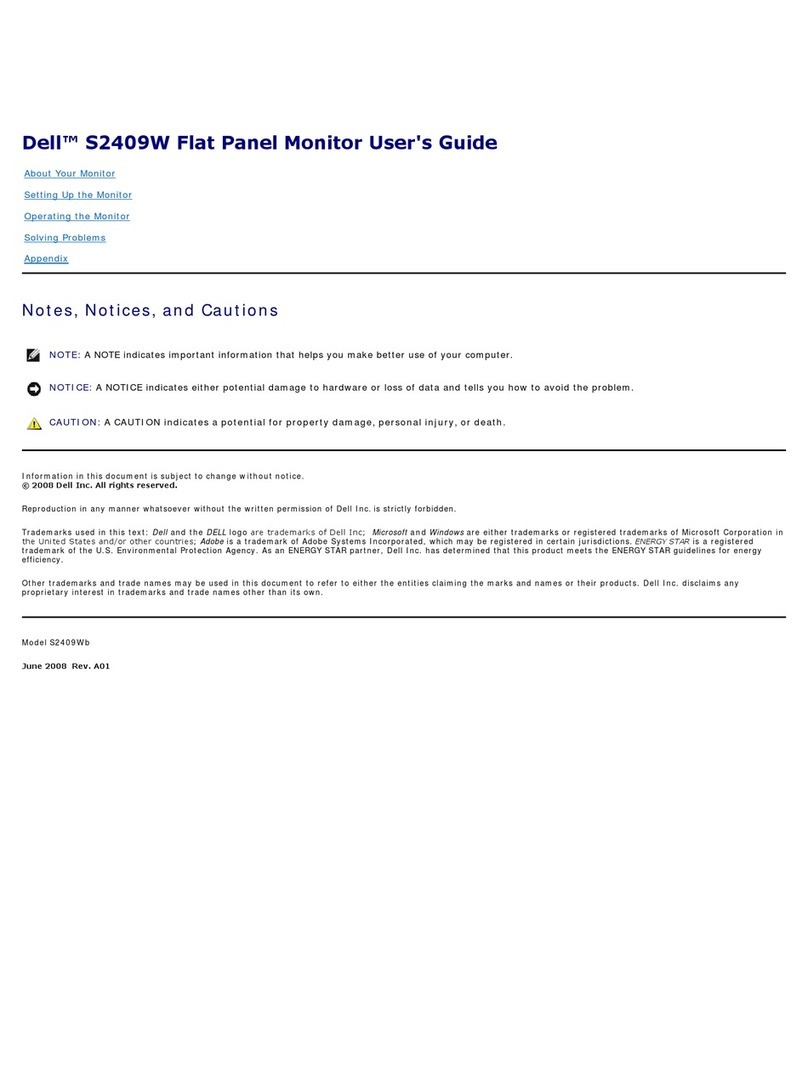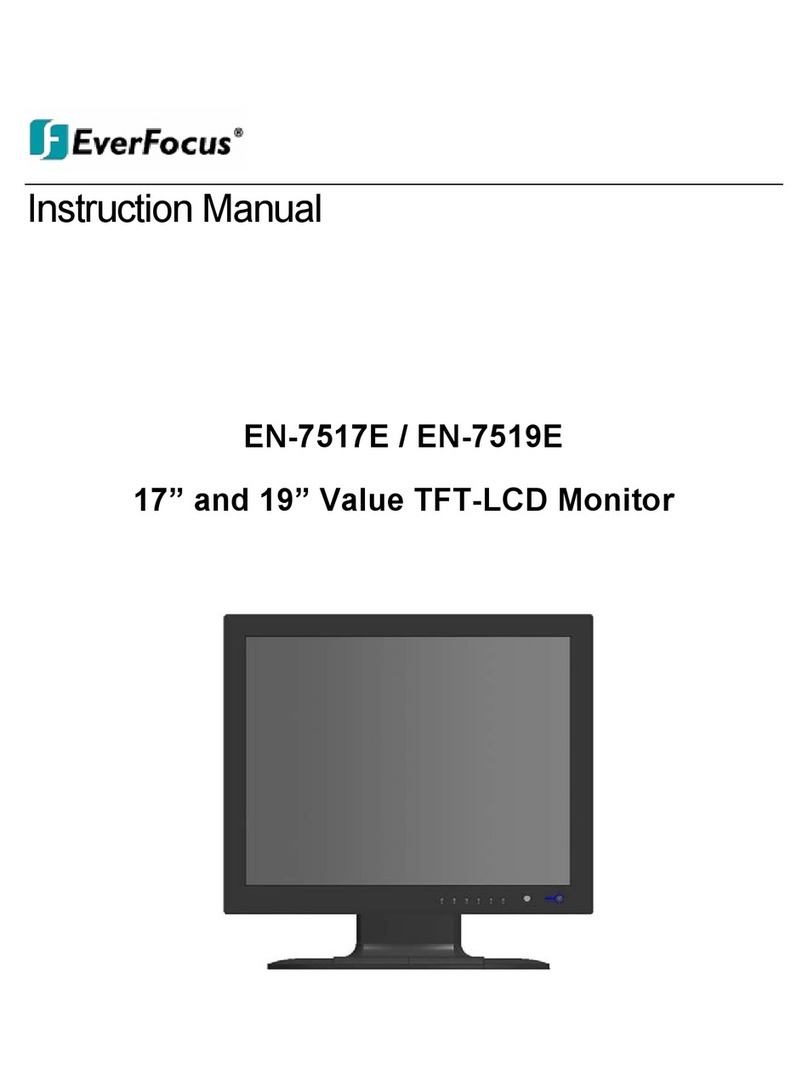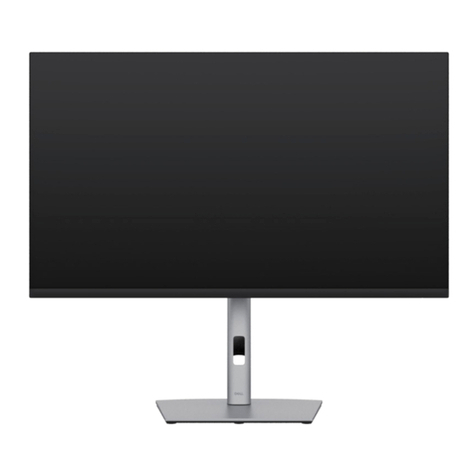Vitalcare 506N3 Series User manual

Cat. No. 1446
Date 08/07 Part No. 39178B101
Revision 1
VitalCareTM
506N3 Series
Patient Monitor
Service Manual

Page ii VitalCareTM 506N3 Series Service Manual Criticare Systems, Inc.
Copyright
COPYRIGHT © CRITICARE SYSTEMS, INC., 2007
CRITICARE SYSTEMS, INC. (Criticare) owns all rights to this unpublished work
and intends to maintain this work as confidential. Criticare may also seek to
maintain this work as an unpublished copyright. This publication is to be used solely for
the purposes of reference, operation, maintenance, or repair of Criticare equipment.
No part of this publication may be reproduced in any manner or disseminated for
other purposes.
In the event of inadvertent or deliberate publication, Criticare intends to enforce its
rights to this work under copyright laws as a published work. Those having access
to this work may not copy, use, or disclose the information in this work unless
expressly authorized by Criticare to do so.
All product specifications, as well as information contained in this publication, are
subject to change without notice.
All information contained in this publication is believed to be correct. Criticare
Systems, Inc., shall not be liable for errors contained herein nor for incidental or
consequential damages in connection with the furnishing, performance, or use of
this material.
This publication may refer to information and products protected by copyrights or
patents and does not convey any license under the patent rights of Criticare
Systems, Inc., nor the rights of others. Criticare Systems, Inc., does not assume
any liability arising out of any infringements of patents or other rights of third
parties.
PROPERTY OF CRITICARE SYSTEMS, INC.
ALL RIGHTS RESERVED
DOX™ oximetry and ComfortCuff™ NIBP technology are trademarks of Criticare
Systems, Inc.
OxiMax®SpO2technology is a registered trademark of Nellcor Puritan Bennett Inc.
FILAC®and FasTemp®are registered trademarks of TYCO Healthcare.
TurboTemp®is a registered trademark of Cardinal Health, Inc.

Criticare Systems, Inc. VitalCareTM 506N3 Series Service Manual Page iii
Copyright.............................................................................................. ii
Contents.............................................................................................. iii
Warranty..............................................................................................ix
Service Return Policy...........................................................................x
EC Declaration .................................................................................... xi
Section 1 — Introduction
Description ........................................................................................1-1
Intended Use.....................................................................................1-2
About this Manual..............................................................................1-2
Non-Invasive Blood Pressure (NIBP)................................................1-3
Comfort Cuff Technology..........................................................1-3
Description of NIBP Measurement ...........................................1-3
Cuff Inflation and Pressure Protection......................................1-4
Heart Rate.........................................................................................1-5
DOX Pulse Oximetry Measurement (SpO2)......................................1-5
Definition...................................................................................1-5
DOX Digital Oximetry................................................................1-5
Method......................................................................................1-6
SpO2Clinical Testing and Accuracy.........................................1-6
Nellcor Pulse Oximetry Measurement (SpO2)...................................1-7
Definition...................................................................................1-7
Method......................................................................................1-7
Automatic Calibration................................................................1-8
Accuracy of OxiMax Sensors....................................................1-8
Functional versus Fractional Saturation ...................................1-8
Measured versus Calculated Saturation...................................1-9
Temperature....................................................................................1-10
Predictive Mode......................................................................1-10
Continuous Mode....................................................................1-11
Axillary Measurements ...........................................................1-11
Clinical Testing and Accuracy.................................................1-11
Specifications ..................................................................................1-12
Symbols...........................................................................................1-16
Safety ..............................................................................................1-18
Software Error Related Hazard Mediation..............................1-19
Potential Interference..............................................................1-19
Leakage Current.....................................................................1-19
Voltage Fluctuations...............................................................1-20
Defibrillation, HF, and Electronic Device Protection...............1-20
Biocompatibility.......................................................................1-20
Latex Content .........................................................................1-20
DEHP Content ........................................................................1-20
Contents

Page iv VitalCareTM 506N3 Series Service Manual Criticare Systems, Inc.
Section 2 — Service Menus
Introduction....................................................................................... 2-1
Service Mode.................................................................................... 2-1
Service Menus ......................................................................... 2-1
Primary Service Displays......................................................... 2-1
Secondary Service Displays .................................................... 2-2
Service Display List.................................................................. 2-2
Self Tests................................................................................. 2-4
NIBP Calibration Mode..................................................................... 2-6
LCD Text Display.............................................................................. 2-7
Using the Menus...................................................................... 2-7
Exit the Menu........................................................................... 2-7
Factory Defaults................................................................................ 2-8
Alarm Menu.............................................................................. 2-8
Parameter Setup...................................................................... 2-8
Printer Setup............................................................................ 2-9
Configuration Menu.................................................................. 2-9
NIBP Cycle Menu..................................................................... 2-9
Trend Menu............................................................................ 2-10
Patient Menu.......................................................................... 2-10
User Defaults.................................................................................. 2-10
Setting User Defaults............................................................. 2-10
Power Up in Service Mode..................................................... 2-11
Saving Unit Defaults............................................................... 2-11
Alarm Menu .................................................................................... 2-13
Alarm Volume......................................................................... 2-13
Pulse Volume......................................................................... 2-13
High Pulse.............................................................................. 2-14
Low Pulse............................................................................... 2-14
High SpO2.............................................................................. 2-14
Low SpO2 .............................................................................. 2-14
High Systolic .......................................................................... 2-14
Low Systolic........................................................................... 2-14
High Diastolic......................................................................... 2-14
Low Diastolic.......................................................................... 2-14
High MAP............................................................................... 2-14
Low MAP................................................................................ 2-14
High Temperature.................................................................. 2-15
Low Temperature................................................................... 2-15
Parameter Setup Menu................................................................... 2-15
Temperature Mode................................................................. 2-15
Degrees F/C........................................................................... 2-15
SpO2 Search.......................................................................... 2-15
NIBP Tone.............................................................................. 2-15
SpO2Average........................................................................ 2-15
Printer Setup Menu......................................................................... 2-16
On NIBP................................................................................. 2-16
On Alarm................................................................................ 2-16
Interval ................................................................................... 2-16
Print To................................................................................... 2-16
Serial...................................................................................... 2-16
Baud Rate.............................................................................. 2-16

Criticare Systems, Inc. VitalCareTM 506N3 Series Service Manual Page v
Configuration Menu.........................................................................2-17
Date........................................................................................2-17
Time........................................................................................2-17
Hour........................................................................................2-17
Minute.....................................................................................2-17
Day .........................................................................................2-17
Month......................................................................................2-17
Year........................................................................................2-17
Contrast ..................................................................................2-17
Temperature...........................................................................2-17
SpO2.......................................................................................2-17
NIBP .......................................................................................2-17
Enable MAP............................................................................2-17
International Configuration Settings ................................................2-18
Language................................................................................2-18
Trend Button Settings......................................................................2-18
Interval....................................................................................2-18
Format ....................................................................................2-18
Span .......................................................................................2-18
Patient Button Settings....................................................................2-18
Section 3 — Theory of Operation
System Architecture..........................................................................3-1
Module Architecture ..........................................................................3-2
Main Board ...............................................................................3-2
Display Board ...........................................................................3-2
NIBP Module.............................................................................3-3
DOX Module .............................................................................3-3
Nellcor Module..........................................................................3-3
Nellcor Carrier Board................................................................3-3
Temperature Modules...............................................................3-4
FasTemp Isolation Board..........................................................3-4
Printer Module ..........................................................................3-4
Block Diagram...................................................................................3-5
Section 4 — Cleaning and Disinfecting
Cleaning and Disinfecting..................................................................4-1
Blood Pressure Cuffs................................................................4-1
DOX Pulse Oximeter Sensors ..................................................4-2
OxiMax Pulse Oximeter Sensors..............................................4-2
Temperature Probes.................................................................4-4
Accidental Wetting.............................................................................4-5

Page vi VitalCareTM 506N3 Series Service Manual Criticare Systems, Inc.
Section 5 — Preventative Maintenance
Incoming Inspection.......................................................................... 5-1
Maintenance Schedule..................................................................... 5-1
Long-Term Storage........................................................................... 5-1
Service Checks................................................................................. 5-1
Calibration......................................................................................... 5-1
Serviceable Components.................................................................. 5-2
Battery Removal/Replacement ................................................ 5-2
Fuse Removal/Replacement.................................................... 5-4
Annual Testing.................................................................................. 5-5
Accessory Testing.................................................................... 5-5
Functional and Safety Testing.................................................. 5-5
Equipment and Tools............................................................... 5-6
Test Fixtures ............................................................................ 5-7
Electrical Safety Tests .................................................................... 5-10
Withstanding Voltage Test (Hi-Pot)........................................ 5-10
Equipment Needed ................................................................ 5-10
Setup Hi-Pot Tester................................................................ 5-10
Hi-Pot Performance Test........................................................ 5-11
Leakage Testing..................................................................... 5-13
Setup Procedure (Self-Test) .................................................. 5-13
Leakage Procedure................................................................ 5-14
Functional Tests ............................................................................. 5-16
System Check........................................................................ 5-16
Speaker Performance, Alarms Verification............................ 5-17
Power Supply Performance ................................................... 5-18
Printer Performance............................................................... 5-18
Monitoring Module Verification ....................................................... 5-19
NIBP Verification.................................................................... 5-19
NIBP Seal Test....................................................................... 5-20
SpO2Verification: CSI DOX Only .......................................... 5-21
SpO2Verification: Nellcor Only.............................................. 5-21
Temperature Verification........................................................ 5-23
Functional and Safety Testing Checklist......................................... 5-25
Section 6 — Service Testing & Calibration
Monitor Testing................................................................................. 6-1
Service Checks........................................................................ 6-1
Field Service Testing........................................................................ 6-1
Equipment and Tools............................................................... 6-2
Communication Testing.................................................................... 6-3
Equipment Required ................................................................ 6-3
Pinout Chart............................................................................. 6-3
Procedure................................................................................. 6-3
DOX SpO2Performance Testing...................................................... 6-4
Programming the SmartSat Analyzer....................................... 6-4
Test Procedure......................................................................... 6-4
Nellcor SpO2Performance Testing .................................................. 6-5
Programming the SmartSat Analyzer....................................... 6-5
Test Procedure......................................................................... 6-5

Criticare Systems, Inc. VitalCareTM 506N3 Series Service Manual Page vii
NIBP Calibration................................................................................6-6
Equipment Required.................................................................6-6
Installing the PC Service Program............................................6-6
Configuring the Ports................................................................6-6
Setup ........................................................................................6-7
Calibrate ...................................................................................6-8
Safety Test..............................................................................6-11
Speed Test .............................................................................6-14
Leak Test................................................................................6-16
Accuracy Test.........................................................................6-20
Other Module Testing and Calibration.............................................6-22
Section 7 — Disassembly
Before You Begin ..............................................................................7-1
Service Safety...........................................................................7-1
Electrostatic Discharge Protection............................................7-2
Tools Needed ...........................................................................7-2
Replace the Printer............................................................................7-3
Replace the Temperature Boards .....................................................7-5
Replacing the FasTemp Isolation Board...................................7-6
Replacing the FasTemp Board.................................................7-8
Replacing the TurboTemp Board............................................7-12
Replace the SpO2Board.................................................................7-13
DOX SpO2with TurboTemp or without Temperature.............7-14
DOX SpO2with FasTemp.......................................................7-15
Nellcor SpO2PCB/Carrier Board with TurboTemp or
without Temperature...............................................................7-18
Nellcor SpO2with FasTemp...................................................7-19
Front Bezel Service.........................................................................7-22
Disassemble Front Bezel from Rear Housing.........................7-22
Replace Main Board...............................................................7-24
Replace Speaker....................................................................7-29
Replace LCD and LED Display Boards ..................................7-31
Replace Membrane ................................................................7-35
Chassis Service/Pump Disassembly...............................................7-39
Replace ComfortCuff NIBP Module........................................7-41
Replace Power Supply ...........................................................7-42
Completion of Service.....................................................................7-43
Section 8 — Troubleshooting
Troubleshooting Guide......................................................................8-1

Page viii VitalCareTM 506N3 Series Service Manual Criticare Systems, Inc.
Section 9 — Drawings and Schematics
List of Drawings................................................................................ 9-1
Assembly Parts Lists................................................................ 9-1
PCB Drawing List.............................................................................. 9-2
Final Assemblies............................................................................... 9-3
506DN3.................................................................................... 9-3
506DNP3.................................................................................. 9-3
506DNT3.................................................................................. 9-4
506DNTP3 ............................................................................... 9-5
506LN3..................................................................................... 9-5
506LNP3.................................................................................. 9-6
506LNT3 .................................................................................. 9-7
506LNTP3................................................................................ 9-8
506DNV3.................................................................................. 9-9
506DNVP3............................................................................... 9-9
506LNV3................................................................................ 9-10
506LNVP3.............................................................................. 9-10
506N3..................................................................................... 9-11
506NP3.................................................................................. 9-11
506NT3 .................................................................................. 9-12
506NTP3................................................................................ 9-12
506NV3.................................................................................. 9-13
506NVP3................................................................................ 9-13
Base Assemblies ............................................................................ 9-14
Without Temperature ............................................................. 9-14
With Temperature .................................................................. 9-14
NIBP Only .............................................................................. 9-15
NIBP/TEMP............................................................................ 9-15
Front Bezel ..................................................................................... 9-16
Non-Temperature................................................................... 9-16
Temperature........................................................................... 9-16
NIBP Only .............................................................................. 9-17
NIBP/TEMP............................................................................ 9-17
Rear Housing Assembly................................................................. 9-18
Chassis Assembly .......................................................................... 9-18
NIBP ............................................................................................... 9-19
Module ................................................................................... 9-19
Pneumatic.............................................................................. 9-19
PCB Assembly................................................................................ 9-20
Printer Assembly............................................................................. 9-20
Appendix A — Main Board Upgrades
Overview...........................................................................................A-1
Battery Disconnect Warning Inducator.....................................A-1
Backward Compatability...................................................................A-1
Upgrading the Main Board................................................................A-2
Removing the old Main Board..................................................A-2
Installing the new Main Board..................................................A-4

Criticare Systems, Inc. VitalCareTM 506N3 Series Service Manual Page ix
Warranty
Workmanship &
Materials
Criticare Systems, Inc. (CSI) warranties the 506N3 Series monitor to
be free from defects in workmanship and materials for a period of one
(1) year from date of shipment under normal use and service. The
monitor warranty does not include batteries, sensors, probes, cables,
cuffs, and hoses. CSI’s obligation under this warranty is limited to
repairing or replacing, at CSI’s option, any part which upon CSI’s
examination proves defective.
Nellcor accessories carry a 90 day warranty.
EXCEPT AS DESCRIBED IN THE PARAGRAPH ABOVE, CSI
MAKES NO WARRANTIES, EXPRESS OR IMPLIED, INCLUDING
ANY WARRANTY OF MERCHANTABILITY OR FITNESS FOR A
PARTICULAR PURPOSE.
Exemptions
CSI’s obligation or liability under this warranty does not include any
transportation or other charges or liability for direct, indirect or
consequential damages or delay resulting from the improper use or
application of the product or the substitution upon it of parts or
accessories not approved by CSI or repair by anyone other than a
CSI authorized representative.
This warranty shall not extend to any instrument which has been
subjected to misuse, negligence or accident; any instrument from
which CSI’s original serial number tag or product identification
markings have been altered or removed; or any product of any other
manufacturer.
Safety, Reliability &
Performance
Criticare Systems, Inc. is not responsible for the effects on safety,
reliability and performance of the 506N3 Series patient monitors if:
assembly operations, extensions, readjustments, modifications or
repairs are carried out by persons other than those authorized by
Criticare Systems, Inc., or
the 506N3 Series monitors are not used in accordance with the
instructions for use, or
the electrical installation of the relevant room does not comply with
NFPA 70: National Electric Code or NFPA 99: Standard for Health
Care Facilities (Outside the United States, the relevant room must
comply with all electrical installation regulations mandated by the
local and regional bodies of government).
In Case of Emergency
Contact
CRITICARE SYSTEMS, INC. Telephone: (262) 798-8282
20925 Crossroads Circle Tech Support: (800) 458-2697
Waukesha, WI 53186 Orders: (800) 458-4615
USA Fax: (262) 798-8290
Internet: www.csiusa.com

Page x VitalCareTM 506N3 Series Service Manual Criticare Systems, Inc.
Service Return Policy
Return Procedure
In the event that it becomes necessary to return a unit to Criticare
Systems, Inc., the following procedure should be followed:
Obtain return authorization. Contact the CSI Service Department
at 800-458-2697 to obtain a Customer Service Authorization (CSA)
number. (Outside the US, call 001-262-798-8282.) The CSA number
must appear on the outside of the shipping container. Return
shipments will not be accepted if the CSA number is not clearly
visible. Please provide the model number, serial number, and a brief
description of the reason for return.
Freight policy. The customer is responsible for freight charges when
equipment is shipped to CSI for service (this includes customs
charges).
Loaner service. In the U.S. If it is necessary to provide a loaner
system, CSI will ship a loaner by overnight courier. The loaner system
must be returned to CSI at the customer’s expense within one week
after receipt of the repaired goods. If the unit is not returned to CSI
within that time, the customer will be invoiced for the full purchase
price of the equipment.
Outside the U.S. No loaners are available from CSI internationally.
Contact your local CSI representative.
Incoming Inspection
The following incoming inspection is required whether it is a first time
arrival or a return from service. Prior to clinical use, the instrument
should be inspected for the following.
1. The quality inspection seal on the instrument should be
unbroken. This seal indicates that the instrument has been
tested according to manufacturers specifications.
2. No physical damage is observed.
3. The instrument's battery is to be charged by connecting the
instrument to a power outlet for a minimum of 6 hours prior to
clinical use.
4. When connecting the instrument to a power outlet and then
turning the instrument on, all displays appear to function
correctly and no system errors occur.
If a discrepancy to these inspection items is observed, do not use the
instrument and immediately report the discrepancy to the CSI
Service Department.

Criticare Systems, Inc. VitalCareTM 506N3 Series Service Manual Page xi
EC Declaration of Conformity
506N3 Series
Patient Monitors
To view the Declaration of Conformity, visit the Criticare website at
www.csiusa.com. Contact Criticare’s customer service department at
(262) 798-8282 to obtain a faxed copy of the Declaration.
Representative in the
European Union
Criticare Systems Limited
c/o Wright Hassall
9 Clarendon Place
Leamington Spa
Warwickshire
CV 32 5QP
T: 0044 (0) 1926 886688
F: 0044 (0) 1926 885588
For the Attention of: Ref. 45 (or) Mr. L. A. Heizler


Criticare Systems, Inc. VitalCareTM 506N3 Series Service Manual Page 1-1
Section 1 — Introduction
Description
The 506N3 Series patient monitor is a compact vital signs monitor
that measures heart rate and non-invasive blood pressure (NIBP).
Heart rate measurement is determined primarily by the
plethysmographic waveform. For units without the oximeter module,
or when the oximeter is not in use, heart rate is determined from the
blood pressure data using an oscillometric method that measures
during inflation.
Optional configurations include blood oxygen saturation (SpO2),
predictive oral/axillary/rectal temperature and/or an internal printer.
Models are available with a choice of oximeter (DOX or Nellcor
OxiMax) and a choice of predictive temperature (FasTemp or
TurboTemp). The following models are available.
506N3: NIBP, heart rate
506NP3: NIBP, printer, heart rate
506DN3: DOX SpO2, NIBP, heart rate
506DNP3: DOX SpO2, NIBP, printer, heart rate
506DNT3: DOX SpO2, NIBP, FasTemp temperature, heart rate
506DNTP3: DOX SpO2, NIBP, FasTemp temperature, printer, heart rate
506DNV3: DOX SpO2, NIBP, TurboTemp temperature, heart rate
506DNVP3: DOX SpO2, NIBP, TurboTemp temperature, printer, heart rate
506LN3: Nellcor SpO2, NIBP, heart rate
506LNP3: Nellcor SpO2, NIBP, printer, heart rate
506LNT3: Nellcor SpO2, NIBP, FasTemp temperature, heart rate
506LNTP3: Nellcor SpO2, NIBP, FasTemp temperature, printer, heart rate
506LNV3: Nellcor SpO2, NIBP, TurboTemp temperature, heart rate
506LNVP3: Nellcor SpO2, NIBP, TurboTemp temperature, printer, heart rate
506NT3: NIBP, FasTemp temperature, heart rate
506NTP3: NIBP, FasTemp temperature, printer, heart rate
506NV3: NIBP, TurboTemp temperature, heart rate
506NVP3: NIBP, TurboTemp temperature, printer, heart rate

Section 1 —Introduction
Page 1-2 VitalCareTM 506N3 Series Service Manual Criticare Systems, Inc.
Intended Use
This equipment is intended for use only by qualified medical providers
in conjunction with established medical protocols.
All models in the 506N3 series are designed to monitor physiological
parameters of patients, providing the health care provider with
physiological data, alarms, and trend records.
The monitor is designed to be used with only one patient at a time.
About this Manual
This manual contains only the information required to service the
monitor. For information on operation, monitoring, and setting up the
monitor, consult the 506N3 Series Patient Monitor Operator’s
Manual.
This manual is designed to help diagnose and service the
sub-assemblies of the 506N3 Series monitor.
Parts lists and block diagrams are included to help the technician
understand how the monitor systems operate.
Criticare Systems, Inc., does not intend for repair to be performed on
the circuit boards by anyone except the Criticare Service
Department.
NOTE: The proceeding items in this section address all possible
functions and options of the 506N3 Series patient monitor.
Depending on the model and features of your unit, some items may
not apply.

Criticare Systems, Inc. VitalCareTM 506N3 Series Service Manual Page 1-3
Section 1 —Introduction
Non-Invasive Blood
Pressure (NIBP)
The 506N3 Series monitor uses ComfortCuff™technology to
determine non-invasive blood pressure by means of oscillometry. The
oscillometric method detects volume displacements within the artery
and senses pressure variations within the blood pressure cuff during
inflation. The monitor uses cuffs ranging in size from neonate cuffs to
adult thigh cuffs.
Comfort Cuff Technology
ComfortCuff technology measures NIBP while the cuff inflates.
Consequently, a measurement is obtained more quickly and with less
discomfort than with monitors which measure NIBP during cuff
deflation.
• This device was clinically tested per the requirements of
EN 1060 and AAMI SP-10.
• The NIBP monitor generates alarm messages in situations of
extremely irregular heart beat or patient motion. The monitor
automatically attempts a second measurement in either case.
Description of NIBP
Measurement
The NIBP cuff begins to inflate at the beginning of the NIBP
measurement cycle. As the cuff pressure approaches the diastolic
pressure of the patient, the cuff pressure waveform begins to indicate
the pulse waveform. The cuff pressure at this point is equal to the
patient's diastolic pressure, which is stored by the monitor.
As cuff pressure continues to increase, the pulse waveform (as
measured from BP cuff pressure fluctuation) becomes stronger,
reaching its maximum at the patient's mean arterial pressure (i.e.,
when cuff pressure = mean BP). The monitor stores this value as
mean pressure.
As cuff pressure increases further, it approaches the patient's systolic
pressure, and the cuffs pulse waveform decreases in amplitude. The
cuff pulse waveform disappears at the point where cuff pressure is
equal to the patient's systolic pressure.
When the monitor determines that the cuff waveform has decreased
to zero amplitude, it stores the cuff pressure value as the systolic
pressure, and releases the pressure from the cuff. This typically
occurs at about 10 mmHg over the patient's systolic pressure. The
cuff then rapidly deflates. Because of the pulsatile nature of the
pressure values, the inflation range needs to exceed the systolic and
diastolic values. The dynamic measurement ranges are:
Adult: 35 to 280 mmHg
Pediatric: 35 to 130 mmHg
Neonate: 25 to 130 mmHg

Section 1 —Introduction
Page 1-4 VitalCareTM 506N3 Series Service Manual Criticare Systems, Inc.
Cuff Inflation and
Pressure Protection
The maximum allowable cuff pressure is 300 mmHg adult mode (150
mmHg in neonate mode). Adult mode cuff pressure is allowed to
remain above 15 mmHg for a maximum of 180 seconds. Neonatal
mode cuff pressure is allowed to remain above 5 mmHg for a
maximum of 90 seconds.
The monitor automatically deflates the cuff if the time limit is violated.
The monitor contains hardware protection for overpressure
conditions, pressure transducer failures, or microprocessor and pump
control circuit failures.
Figure 1-1: NIBP Cuff Pressure and Pulse over Time
B.P Cuff Inflation Pressure
(Shown during inflation)
Systolic Pressure
Cuff deflates rapidly after
monitor determines systolic
pressure
Time
Diastolic
Pressure Mean Pressure Systolic
Pressure
Pulse Waveform
(Measured from B.P. Cuff
Pressure Fluctuation)
Pressure in mmHg
Diastolic Pressure
Actual Blood
Pressure Waveform

Criticare Systems, Inc. VitalCareTM 506N3 Series Service Manual Page 1-5
Section 1 —Introduction
Heart Rate
Heart rate measurement is determined primarily by the
plethysmographic (SpO2) waveform. When the oximeter is not in use,
the heart rate is determined from the blood pressure data using an
oscillometric method that measures during inflation. The unit of
measurement is beats per minute.
Under conditions where the plethysmographic based heart rate and
the oscillometric heart rate are both beyond the detectable limits of
the monitor, no heart rate is reported. Also, no heart rate is reported
where the amplitude of the plethysmographic waveform and
oscillometric waveform are beyond the detectable limits. The monitor
reports error messages if valid measurements cannot be obtained.
The monitor continues to look for valid SpO2based heart rate
measurements and attempts a second NIBP measurement if the first
attempt fails.
DOX
TM
Pulse Oximetry
Measurement (SpO
2
)
The 506N3 Series monitor is available with Digital Oximetry (DOX™)
technology to measure blood oxygen saturation (SpO2).
Definition
Hemoglobin exists in the blood in several forms:
• Oxygenated (Oxyhemoglobin)
• Reduced (Deoxyhemoglobin)
• Dyshemoglobins (carboxyhemoglobin and methemoglobin.)
In the monitor, SpO2(pulse arterial oxygen saturation) is the ratio of
oxygenated hemoglobin to the sum of oxygenated hemoglobin plus
hemoglobin which is available for binding to oxygen, as expressed in
the following formula:
Dyshemoglobins, such as carboxyhemoglobin and methemoglobin,
are not directly measured and therefore are not factored into the
measurement.
DOX Digital Oximetry
The monitor does not use analog circuitry for signal processing.
Digital signal processing in the microprocessor results in lower noise
from circuitry components, resulting in a cleaner signal and better
performance under low perfusion conditions. There is also improved
rejection of noise from the patient and environment, due to the
availability of the “true,” unfiltered sensor signal for digital signal
processing.
percent oxygen saturation = x 100
oxyhemoglobin
oxyhemoglobin + deoxyhemoglobin

Section 1 —Introduction
Page 1-6 VitalCareTM 506N3 Series Service Manual Criticare Systems, Inc.
Method
The digital pulse oximeter measures oxygen saturation and pulse rate
using the principles of spectrophotometry and plethysmography. The
sensor is completely non-invasive, and there is no heat source that
could burn the patient.
The pulse oximeter sensor contains two types of LEDs; each type
emits a specific wavelength of light. Since oxygenated hemoglobin
and deoxygenated hemoglobin absorb light selectively and
predictably, the amounts of these two compounds can be determined
by measuring the intensity of each wavelength that passes through
the measuring site.
The light from the LEDs shines into a pulsating vascular bed. A
photodetector located opposite or alongside the LEDs measures the
intensity of each wavelength transmitted through the monitoring site.
The light intensity is converted to an electrical signal, which is input to
the monitor. The effects of skin pigmentation, venous blood, and
other tissue constituents are eliminated by separating out the
pulsating absorption data.
SpO2is calculated with every pulse and averaged with the results
from previous pulses to arrive at the current numeric display value.
The display is updated at least once per second with the numeric
values that were calculated during the intervening period.
The plethysmographic pulse bar is not auto-gained. The amplitude
display of the plethysmographic pulse bar is proportional to the pulse
volume changes occurring in the tissue illuminated by the SpO2
sensor.
SpO
2
Clinical Testing
and Accuracy
All Criticare Systems, Inc., oximeters have SpO2calibration tables
which were originally generated by monitoring desaturated human
patients or volunteers and matching their displayed SpO2value to the
value determined by sampling arterial blood and measuring
functional SaO2with a clinical laboratory grade multi wavelength
optical oximeter (i.e. CO-oximeter). The final SpO2calibration curve
was then generated based upon numerous patients' data over the
range of 40 to 99% SaO2. All accepted data were taken from patients
with dyshemoglobin (i.e., carboxyhemoglobin, methemoglobin)
concentrations near zero.
This oximeter is a two-wavelength device, which is calibrated to
measure functional SpO2only when dyshemoglobin concentrations
are near zero. The accuracy specifications of this device will not be
met with high concentrations of dyshemoglobins. Significant
concentrations of carboxyhemoglobin results in a higher displayed
SpO2value than is actually present in the patient.

Criticare Systems, Inc. VitalCareTM 506N3 Series Service Manual Page 1-7
Section 1 —Introduction
Nellcor Pulse Oximetry
Measurement (SpO
2
)
The 506N3 Series monitor is also available with Nellcor OxiMax®
technology to measure blood oxygen saturation (SpO2).
Definition
The Nellcor OxiMax uses pulse oximetry to measure functional
oxygen saturation in the blood. Pulse oximetry works by applying an
OxiMax sensor to a pulsating arteriolar vascular bed, such as a finger
or toe. The OxiMax sensor contains a dual light source and a photo
detector.
Because a measurement of SpO2is dependent upon light from the
OxiMax sensor, excessive ambient light can interfere with this
measurement.
Criticare’s implementation of the OxiMax oximeter rounds down
SpO2 saturation values above 99.6% that might normally be reported
as 100% oxygen saturation in other implementations.
Method
Pulse oximetry is based on two principles: that oxyhemoglobin and
deoxyhemoglobin differ in their absorption of red and infrared light
(spectrophotometry), and that the volume of arterial blood in tissue
(and hence, light absorption by that blood) changes during the pulse
(plethysmography). A pulse oximeter determines SpO2by passing
red and infrared light into an arteriolar bed and measuring changes in
light absorption during the pulsatile cycle. Red and infrared low-
voltage light-emitting diodes (LED) in the oximetry OxiMax sensor
serve as light sources; a photo diode serves as the photo detector.
Because oxyhemoglobin and deoxyhemoglobin differ in light
absorption, the amount of red and infrared light absorbed by blood is
related to hemoglobin oxygen saturation. To identify the oxygen
saturation of arterial hemoglobin, the monitor uses the pulsatile
nature of arterial flow. During systole, a new pulse of arterial blood
enters the vascular bed, and blood volume and light absorption
increase. During diastole, blood volume and light absorption reach
their lowest point. The pulse oximeter bases its SpO2measurements
on the difference between maximum and minimum absorption
(measurements at systole and diastole). By doing so, it focuses on
light absorption by pulsatile arterial blood, eliminating the effects of
nonpulsatile absorbers such as tissue, bone, and venous blood.
The display is updated at least once per second with the numeric
values that were calculated during the intervening period.
The plethysmographic pulse bar is not auto-gained. The amplitude
display of the plethysmographic pulse bar is proportional to the pulse
volume changes occurring in the tissue illuminated by the SpO2
sensor.

Section 1 —Introduction
Page 1-8 VitalCareTM 506N3 Series Service Manual Criticare Systems, Inc.
Automatic Calibration
During monitoring, the instrument's software selects coefficients that
are appropriate for the wavelength of that individual OxiMax sensor's
red LED; these coefficients are then used to determine SpO2.
Additionally, to compensate for differences in tissue thickness, the
light intensity of the OxiMax sensor's LEDs is adjusted automatically.
Accuracy of
OxiMax Sensors
The accuracies of the OxiMax sensors are listed in the following
chart:
Functional versus
Fractional Saturation
This pulse oximeter measures functional saturation ñ oxygenated
hemoglobin expressed as a percentage of the hemoglobin that can
transport oxygen. It does not detect significant amounts of
dysfunctional hemoglobin, such as carboxyhemoglobin or
methemoglobin. In contrast, hemoximeters such as the IL482 report
fractional saturation ñ oxygenated hemoglobin expressed as a
percentage of all measured hemoglobin, including measured
dysfunctional hemoglobins. To compare functional saturation
measurements to those from an instrument that measures fractional
saturation, fractional measurements must be converted as follows:
OxiMax Sensor Models SpO2Range 70-100%
Single Use Sensors
MAX-A, MAX-AL ± 2
MAX-N (Adult) ± 2
MAX-N (Neonate) ± 3
MAX-P ± 2
MAX-I ± 2
MAX-FAST ± 2
Reusable Sensors
D-YS (Infant to Adult) ± 3
D-YS (Neonate) ± 4
D-YS & D-YSE (Neonate) ± 3.5
D-YS & D-YSPD ± 3.5
DS-100A ± 3
OXI-A/N (Adult) ± 3
OXI-A/N (Neonate) ± 4
OXI-P/I ± 3
functional saturation = x 100
fractional saturation
100 - (%carboxyhemoglobin + % methemoglobin )
This manual suits for next models
17
Table of contents
